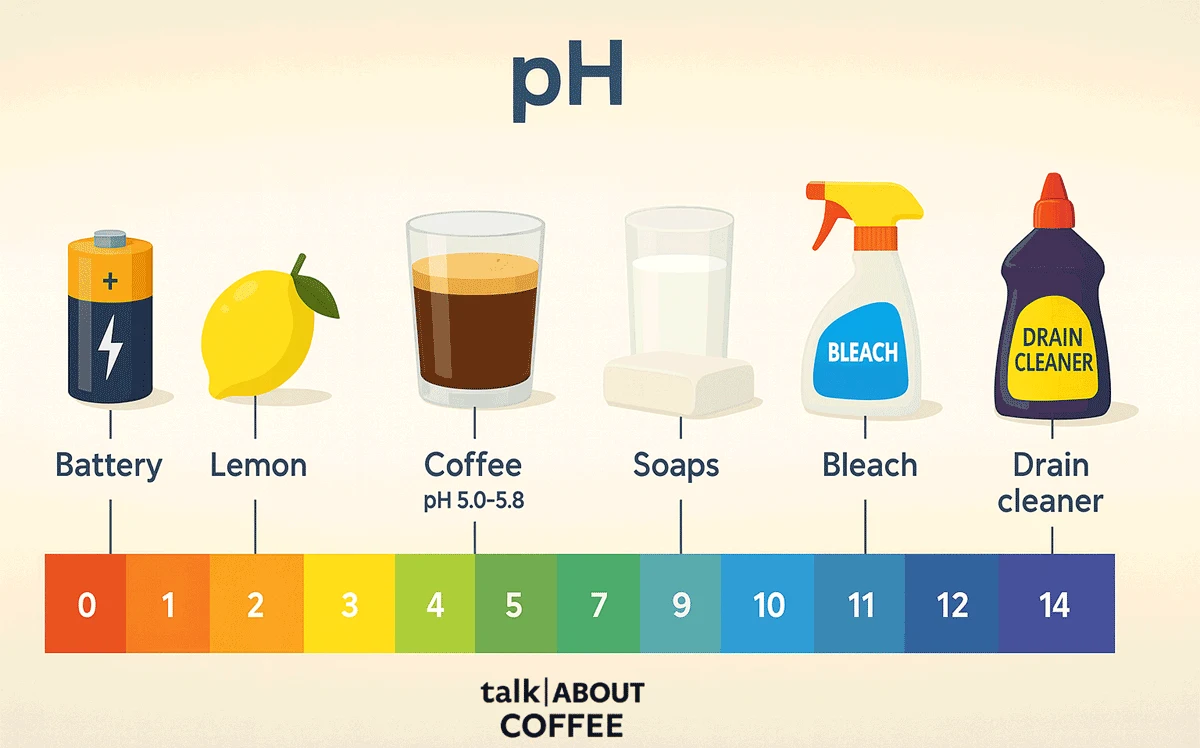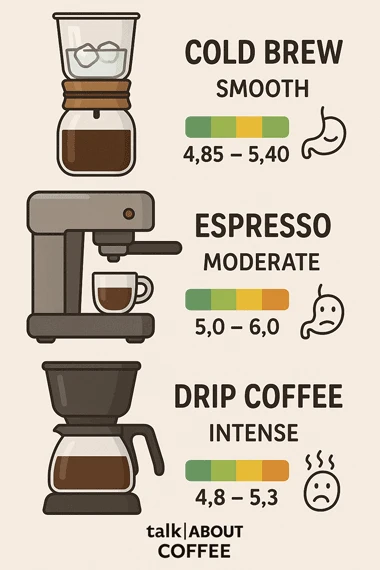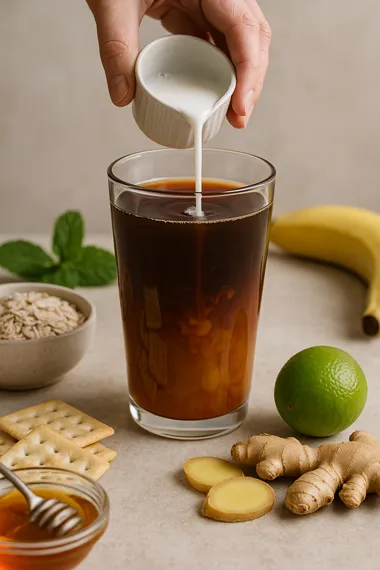See the scan copy. Let’s try Gf$% More Coffee Articles The Down-low on Low...

This article was last updated on August 31, 2025 to include the latest information.
Coffee and I have a complicated relationship. I love everything about it – the aroma, the ritual, the way it makes my brain work in the morning. But about three years ago, coffee started loving me back in all the wrong ways. Heartburn, acid reflux, that burning sensation that made me question whether my daily coffee habit was worth the pain.
My doctor’s advice was predictable: “Just stop drinking coffee.” Right. Like telling someone to stop breathing. I tried cutting coffee completely for two weeks and felt like a zombie. There had to be a better way.
After researching the science behind coffee and acid production, testing different brewing methods, and trying various solutions, I found ways to enjoy coffee without the digestive drama. Not every method works for everyone, but understanding why coffee causes problems helps you find solutions that actually work for your situation.

Caffeine stimulation – Caffeine increases stomach acid production and can relax the lower esophageal sphincter, allowing acid to reflux upward
Coffee acids – Coffee contains chlorogenic acids, quinides, and other compounds that can irritate sensitive stomachs
Empty stomach effect – Drinking coffee on an empty stomach concentrates these effects when there’s no food to buffer the acid
Individual sensitivity – Genetics, stress levels, and existing digestive issues all affect how your body responds to coffee
Recent research has identified specific compounds in coffee that either increase or decrease its potential to cause acid reflux. Understanding these helps explain why certain brewing methods and coffee choices work better than others.
N-methylpyridinium (NMP) – A compound that actually inhibits stomach acid production. Dark roasts contain more NMP than light roasts.
Chlorogenic acids – Present in higher concentrations in light roasts and contribute to stomach irritation in sensitive individuals.
Caffeine content – Varies significantly by brewing method, roast level, and bean type.

Why it works: Cold brewing extracts fewer acidic compounds while maintaining caffeine content. The resulting coffee has up to 70% less acid than hot-brewed coffee.
How to make it right:
Pro tips:
The science: Espresso’s quick extraction time (20-30 seconds) pulls less acid from the beans compared to drip coffee’s 4-6 minute extraction time.
Best practices:
Making Americanos: If you prefer larger coffee servings, make an Americano by adding hot water to espresso shots rather than brewing drip coffee.
Standard French press can be harsh on sensitive stomachs due to longer extraction times, but modifications help:
Shorter steeping time – Reduce from 4 minutes to 2.5-3 minutes Coarser grind – Reduces extraction of acidic compounds Paper filter addition – Place a paper filter over grounds before pressing to remove more acids
Dark roasts are genuinely better for acid reflux sufferers. Here’s why:
| Roast Level | Acid Content | NMP Content | Best For |
|---|---|---|---|
| Light Roast | High acidic compounds | Low NMP | Avoid if sensitive |
| Medium Roast | Moderate acids | Moderate NMP | Test carefully |
| Dark Roast | Lower acids | High NMP | Best choice |
| French Roast | Lowest acids | Highest NMP | Excellent option |
Flavor considerations: Dark roasts have more chocolate, caramel, and nutty notes rather than bright, fruity flavors.
Lower acid coffee regions:
Higher acid regions to avoid:
Wet processing (washed coffee) tends to create brighter, more acidic coffee
Dry processing (natural) often produces fuller body with less perceived acidity
Honey processing falls between wet and dry, often creating balanced acidity levels
Puroast Coffee – Steam-roasted process reduces acid by up to 70% HealthWise Coffee – Specialized roasting for reduced acid content Hevla Coffee – Low-acid coffee available in various roast levels Volcanica Low Acid Coffee – Specifically sourced and roasted for sensitive stomachs Tieman’s Fusion Coffee – Marketed specifically for acid reflux sufferers
What to expect: These coffees typically cost 20-50% more than regular coffee but provide consistent low-acid results.
Eggshell method – Add clean, crushed eggshells to coffee grounds before brewing. Calcium carbonate neutralizes acids.
Baking soda addition – 1/4 teaspoon per cup reduces acidity, but affects taste significantly
Calcium carbonate tablets – Crush and add to coffee grounds (food-grade only)
Never on empty stomach – Always eat something before or with coffee
Best timing: 1-2 hours after breakfast when stomach acid production is naturally lower
Avoid late afternoon coffee – Can worsen evening heartburn when lying down
Alkaline foods that help neutralize acid:
Foods to avoid with coffee:

Why milk helps: Calcium and proteins in dairy neutralize stomach acid and provide a protective coating.
Best dairy choices:
Avoid: Non-dairy creamers often contain acids and artificial ingredients that can worsen reflux
Alkaline plant milks:
Avoid: Coconut milk can be acidic, and many plant milks contain stabilizers that some people find irritating
Raw honey – Alkaline and may help heal stomach lining (use sparingly due to sugar content)
Cinnamon – Anti-inflammatory properties and may help with digestion
Ginger powder – Small amounts can settle stomach and reduce nausea
Caffeine-free doesn’t mean acid-free – Decaf coffee still contains acids, but removing caffeine eliminates the biggest trigger for acid production
Swiss Water Process decaf – Chemical-free decaffeination that preserves flavor better
CO2 decaffeination – Another chemical-free method that maintains coffee character
Coffee pH basics: Regular coffee has a pH of 4.85-5.10 (acidic). Target pH above 5.5 for sensitive stomachs.
Natural pH adjustment:
Taken with coffee (consult healthcare provider first):
Stress increases acid production and makes coffee-related reflux worse
Helpful practices:
Elevate head while sleeping – Reduces nighttime acid reflux
Stop coffee 6+ hours before bedtime – Prevents late-day acid production
Don’t lie down after coffee – Remain upright for at least 30 minutes
Smaller, more frequent coffee consumption is easier on sensitive stomachs than large amounts at once
Start with half-portions when trying new solutions to test tolerance
Immediate relief:
Natural remedies:
Change one variable at a time:
Keep a coffee diary:
Successful morning routine example:
See a healthcare provider if you experience:
Be specific about:
Give solutions time – Stomach healing can take weeks to months
Gradual reintroduction – If you stop coffee completely, reintroduce slowly with low-acid methods
Overall diet matters – Coffee is just one factor in digestive health
Quality over quantity – Better to have one perfect cup than three problematic ones
Listen to your body – What works can change with stress, age, and health status
Regular evaluation – Reassess your solutions every few months
Cold brewing setup – $20-50 investment provides ongoing low-acid coffee
Dark roast regular coffee – Often cheaper than specialty low-acid brands
Basic milk addition – Simple and effective acid buffering
Specialized low-acid coffee – Worth the cost if you drink coffee daily
Quality grinder – Consistent grind size improves extraction control
Espresso machine – Long-term investment if espresso-based drinks work for you
Coffee-related acid reflux isn’t an all-or-nothing situation. With the right combination of coffee selection, brewing methods, timing, and additions, most people can continue enjoying coffee without digestive distress.
Most effective solutions:
Key principles:
The goal isn’t to eliminate every trace of acid from coffee – that would also eliminate much of what makes coffee taste like coffee. Instead, it’s about finding the sweet spot where you can enjoy your coffee ritual without paying for it later with digestive discomfort.
Remember, everyone’s digestive system is different. What works perfectly for one person might not work for another. The key is understanding the principles behind why coffee causes acid reflux, then systematically testing solutions until you find your personal formula for pain-free coffee enjoyment.
Some posts on our site may contain amazon affiliate links. We may earn affiliate commission from amazon when you purchase through those links.
Valerie Lugo says
After you brush your teeth, drink a full glass of water to ease the overnite empty stomach acids.
Coffee tears up your stomach bc its empty.
M says
What about adding a pinch of baking soda??